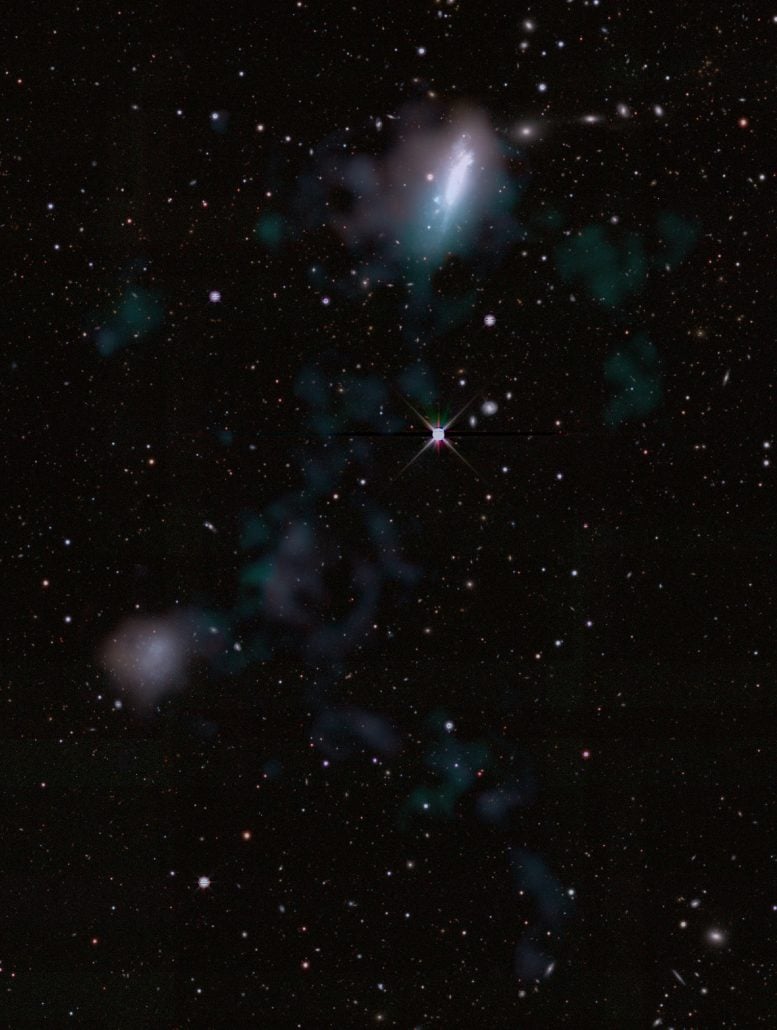
Astronomers have discovered a massive bridge of neutral hydrogen gas that connects two dwarf galaxies.
Scientists at the University of Western Australia node of the International Centre for Radio Astronomy Research (ICRAR) have identified a colossal structure stretching 185,000 light-years, linking the dwarf galaxies NGC 4532 and DDO 137, situated 53 million light-years away from Earth.
Published on September 24, 2025, in the Monthly Notices of the Royal Astronomical Society, the study also revealed an enormous gas tail extending 1.6 million light-years, the longest of its kind ever detected.
Professor Lister Staveley-Smith explains the discovery of a bridge of gas between two galaxies. Credit: ICRAR
Tidal forces and galactic motion
According to lead author Professor Lister Staveley-Smith of ICRAR UWA, the finding represents a major advance in understanding the ways galaxies interact with one another.
“Our modeling showed that the tidal forces acting between these galaxies, alongside their proximity to the massive Virgo cluster of galaxies, played a crucial role in the gas dynamics we observed,” Professor Staveley-Smith said.

He continues, “As the galaxies rotated around each other and moved toward the hot gas cloud surrounding the Virgo cluster, which was 200 times hotter than the Sun’s surface, they experienced what is known as ram pressure, which stripped and heated the gas from the galaxies.
“The process is akin to atmospheric burn-up when a satellite re-enters the Earth’s upper atmosphere, but has extended over a period of a billion years.
“The density of electrons and the speed at which galaxies are falling into the hot gas cloud are enough to explain why so much gas has been pulled away from the galaxies and into the bridge and surrounding areas.”
A rotating pseudo-three-dimensional visualization of the interacting system of NGC 4532 and DDO 137. A faint bridge of gas extends between the two galaxies. Credit: ICRAR
Mapping hydrogen with WALLABY
The discovery was made through the Widefield ASKAP L-band Legacy All-sky Survey (WALLABY), a major program designed to chart the sky and investigate how hydrogen gas is distributed across galaxies. The survey relies on the ASKAP radio telescope, which is managed and operated by CSIRO, Australia’s national science agency.
Co-author Professor Kenji Bekki, an astrophysicist at ICRAR UWA, explained that the team identified the enormous gas structures by conducting high-resolution studies of neutral hydrogen.

“Neutral hydrogen plays a crucial role in the formation of stars, making this finding fundamental to understanding how galaxies interact and evolve, particularly in dense environments,” Professor Bekki said.
Professor Staveley-Smith said the system had strong similarities with our own Milky Way and Magellanic System, providing a unique opportunity to study such interactions in detail.
“Understanding these gas bridges and their dynamics provides critical insights into how galaxies evolve over time, how galactic gas is redistributed, and the varying conditions under which galaxies may or may not form stars,” he said.
“This contributes to our broader understanding of the most massive structures in the Universe and their life cycles, which helps us grasp more about their vast complexities and history of star formation.”
Reference: “WALLABY pilot survey: the extensive interaction of NGC 4532 and DDO 137 with the Virgo cluster” by L Staveley-Smith, K Bekki, A Boselli, L Cortese, N Deg, B -Q For, K Lee-Waddell, T O’Beirne, M E Putman, C Sinnott, J Wang, T Westmeier, O I Wong, B Catinella, H Dénes, J Rhee, L Shao, A X Shen and K Spekkens, 23 September 2025, Monthly Notices of the Royal Astronomical Society.
DOI: 10.1093/mnras/staf1443
This work was supported by the Australian SKA Regional Centre (AusSRC), Australia’s portion of the international SKA Regional Centre Network (SRCNet), funded by the Australian Government through the Department of Industry, Science, and Resources (DISR; grant SKARC000001).
Never miss a breakthrough: Join the SciTechDaily newsletter.